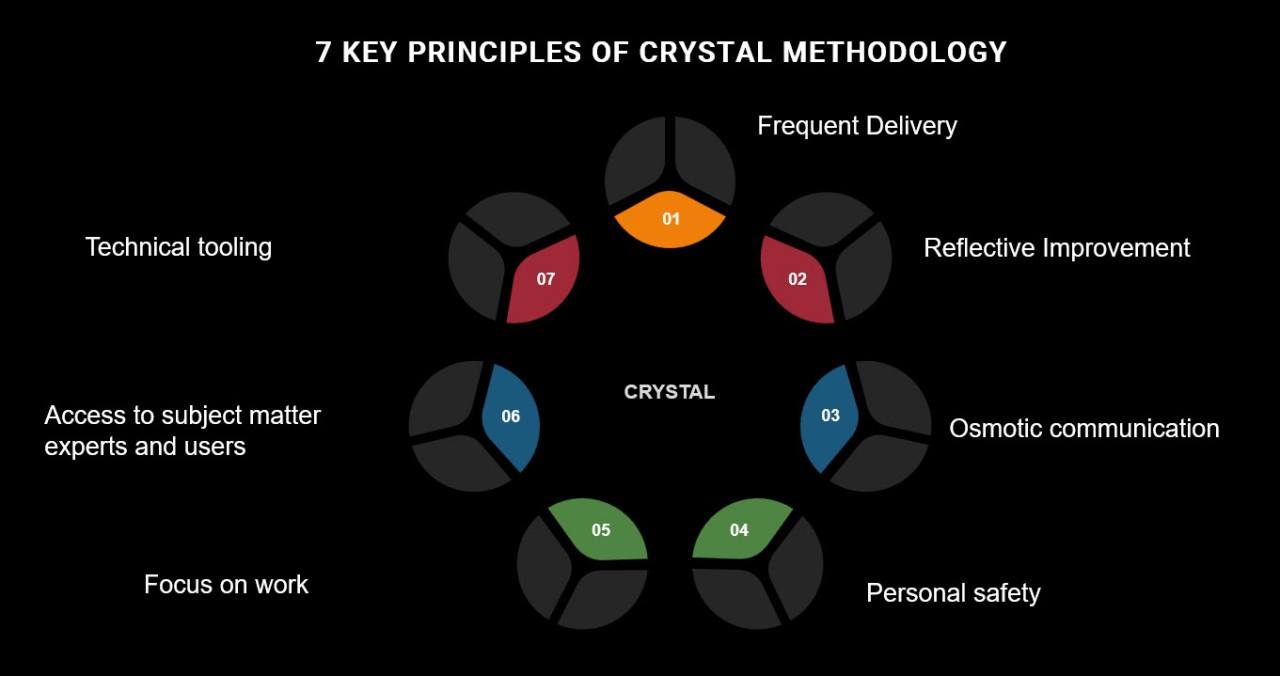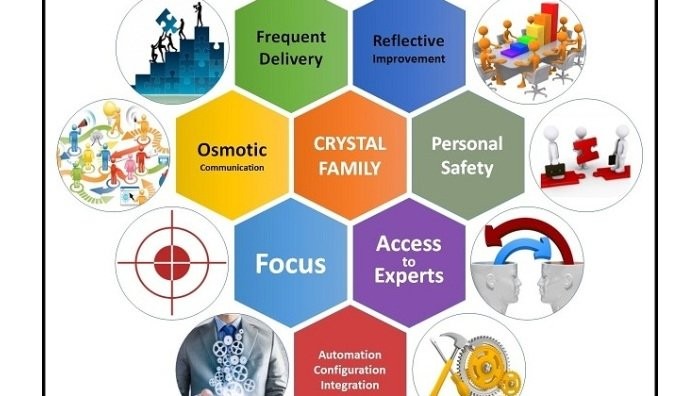Crystal Methodologies for Agile Project Management
Crystal Methodologies, formulated by Alistair Cockburn, are a set of agile methodologies, each tailored to different types of projects. Unlike other extreme agile frameworks such as Scrum, Crystal Methodologies are adaptable and provide a variety of approaches suitable for diverse team sizes, levels of project criticality, and development complexity. In this comprehensive guide, we will explore the core concepts of Crystal Methodologies, their applications, and the practices they involve, particularly from a DevOps perspective.
Overview of Crystal Methodologies
Crystal Methodologies are characterized by adaptability to different types of software projects based on two major dimensions: size and criticality. The name “Crystal” stems from the idea that various projects, like crystals, can be classified by color based on their complexity and scale.
These methodologies were developed specifically to cater to varying project needs—from small teams working in the same location to large-scale projects requiring higher levels of coordination and risk management.
| Crystal Methodology | Team Size and Criticality |
|---|---|
| Crystal Clear | Small teams (up to 8 members), low criticality |
| Crystal Orange | Medium-sized teams, moderate project complexity |
| Crystal Red | Larger teams, high criticality projects |
For smaller teams, Crystal Clear is the most suitable, offering greater freedom and flexibility. However, for projects that require increased coordination and risk management, darker shades such as Crystal Orange and Crystal Red are recommended.
The Seven Properties of Crystal Methodologies
Crystal Methodologies are defined by seven core properties that form the foundation for their application in project management. Each of these properties emphasizes effective team collaboration, frequent delivery, and a supportive working environment.
Frequent Deliveries
Crystal encourages iterative and incremental development, promoting frequent deliveries that provide opportunities for feedback. Deliveries can be made weekly or quarterly, based on project needs.
- Unlike Scrum, which prescribes sprints of 2-4 weeks, Crystal offers flexibility regarding the frequency of deliveries.
- The frequent delivery of features allows teams to gather valuable insights from end users and make necessary adjustments.
Reflective Improvement
Reflective improvement is a central aspect of Crystal. Continuous review and feedback sessions are held to enhance the system, processes, and teamwork.
- Teams conduct weekly meetings to assess project progression and identify areas for improvement.
- The reflective cycle ensures any emerging issues are addressed promptly before they hinder project development.
Osmotic Communication
Osmotic communication involves ensuring that all team members are located in the same physical area whenever possible. This helps in facilitating natural, informal information flow within the team.
| Property | Benefit |
|---|---|
| Shared Workspace | Faster communication, fewer distractions, better focus |
| Collaborative Environment | Enhanced understanding and reduced ambiguities |
- Information flows naturally when team members work in proximity, reducing the need for formal meetings.
- Osmotic communication enables questions to be answered quickly, fostering a more collaborative environment.
Personal Security
Team members should feel comfortable expressing their ideas and opinions. Personal security means that contributions from all members are respected, and no one is judged prematurely.
- Creating an environment where people are not afraid to make mistakes leads to innovation.
- Team morale and participation are enhanced when members feel secure in their roles.
Approach
Crystal emphasizes dedicated, uninterrupted work periods for team members to maintain productivity and achieve project goals. Two-hour blocks of non-interruption are often allocated for core tasks.
- Establishing clear objectives and priorities ensures that team members are always aligned with project goals.
- Dedicated focus periods help in minimizing multitasking, thereby improving productivity.
Easy Access to Expert Users
Frequent interaction with expert users is encouraged in Crystal projects. These interactions do not need to be continuous, but regular meetings (at least weekly) help align the project development with real user needs.
- Regular feedback from expert users helps in adjusting project features according to user expectations.
- Remote communications, such as emails or calls, supplement face-to-face meetings and maintain user involvement.
Technical Environment with Agile Practices
Crystal also incorporates various agile engineering practices including automated testing, configuration management, and continuous integration to maintain a high standard of code quality and facilitate frequent releases.
| Agile Practice | Purpose |
|---|---|
| Automated Testing | Ensures the reliability of each build |
| Configuration Management | Helps track changes systematically |
| Continuous Integration | Allows frequent integration and testing |
- Automated testing helps identify issues earlier, saving time and resources.
- Continuous integration ensures that new changes are compatible with the existing codebase, thus preventing integration issues.
Implementation of Crystal Methodologies
Selecting the Right Crystal Methodology
Depending on team size and project criticality, the right version of Crystal Methodology must be chosen. For smaller, less critical projects, Crystal Clear provides enough flexibility, while larger, more critical projects require Crystal Orange or Crystal Red for effective coordination and risk mitigation.
Applying the Seven Properties
Each of the seven properties discussed should be thoughtfully applied throughout the project lifecycle. For instance, setting up a shared workspace enables osmotic communication, while frequent deliveries allow stakeholders to stay informed of the project’s progress.
Crystal Methodologies provide an adaptable and flexible approach to agile project management. By classifying projects based on size and criticality and applying the seven properties effectively, teams can improve collaboration, ensure regular delivery, and maintain high standards of quality and communication. Crystal stands out in its emphasis on team well-being, iterative improvements, and tailored project management practices.
Whether you are managing a small team on a less critical project or handling a large-scale high-stakes development, selecting the appropriate Crystal Methodology will ensure that your team can collaborate effectively and deliver a successful project outcome.
To implement Crystal effectively, start by choosing the right variant based on project requirements, apply the seven properties to encourage frequent reflection, and maintain open communication among all stakeholders. Crystal’s adaptive nature makes it a valuable tool in a DevOps context where flexibility, fast feedback, and constant delivery are key to success.
For further reading and deeper insight into Crystal Methodologies and other agile frameworks, refer to Crystal.

